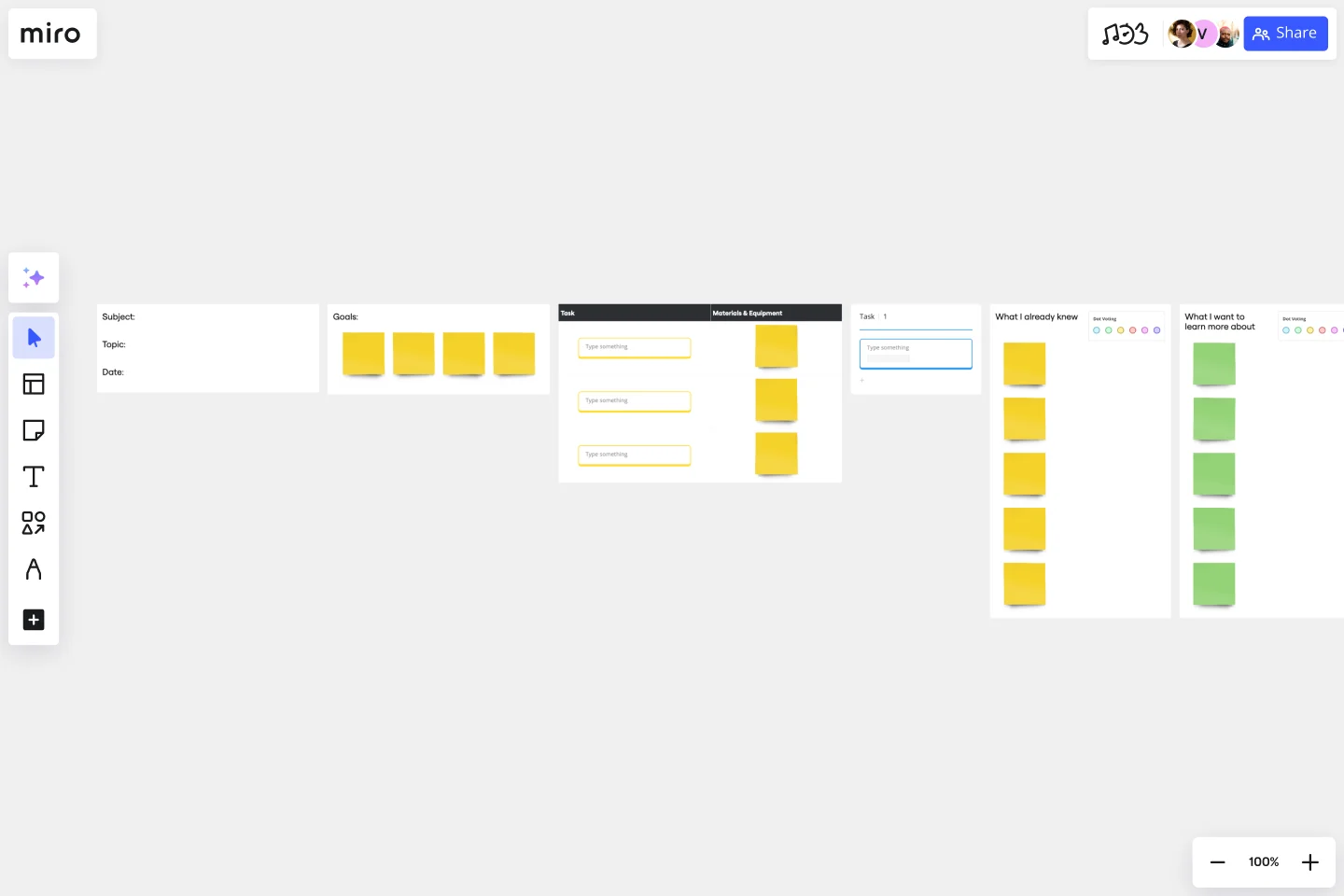Lesson Plan Template
Organize teaching materials and assess student progress and interests.
About the Lesson Plan template
Teachers can use the lesson plan template as a tool to facilitate their learning sessions, to get more clarity when planning lessons, inform everyone about assignments and align expectations. The template also makes it easy to assess the learning experience, ensure the content was well-received, and check if the lession was effective.
What is a lesson plan template?
A lesson plan template is a detailed description of the learning trajectory or the lesson. It consists of five parts: lesson plan, a summary of tasks, assignment, feedback, and further reading.
These are the key areas teachers often work on with the help of the lesson plan, but details can vary depending on the teacher’s preference or institution. When well developed, the lesson plan reflects the students’ interests and needs, and it’s widely adopted as a best practice in the educational field.
It’s essential to view the lesson plan as a thinking process, not only a template. The lesson plan is envisioned to be a blueprint, a guide map for teaching-learning activities. Teachers should keep it flexible but also follow it systematically as they develop teaching concepts.
When to use a lesson plan template
You can use the lesson plan template at the beginning of the lesson. You can also consider a sequence to the lesson plan to follow up consistently with your teaching plan, and allow students to recall what they have learned and connect to what’s coming next.
How to use the lesson plan template in Miro
You can easily make your lesson plan with Miro’s template. Our collaborative platform is the perfect canvas to create and share with your students.
Get started by selecting the lesson plan template, then take the following steps to make one of your own:
Lesson plan: add here the basic information about your lesson plan, such as topic, date, and learning goals.
Summary of tasks: outline your lesson plan and briefly describe your students’ tasks.
Assignment: this section is where you can describe in detail the lesson assignment and explain to your students what they will do.
Feedback: leave this field for your students to fill, and later on, when analyzing it, you can cluster the topics and identify interests, improvements, and successes.
Further reading: in this section, you can freely suggest additional readings, interesting resources and even add other links and images related to your lesson, be creative!
How do you write a lesson plan?
Write your lesson plan with clear instructional language as it will be a guide map to your lesson. Please make sure the learning goals are clear and your students understand their assignments. Keep it informal and use a friendly tone of voice to give space for your students to feel more comfortable and at ease when following your lesson plan.
What are the 5 parts of the lesson plan?
The lesson plan template has five parts: Lesson plan with basic information about the topic Summary of tasks Assignment details Feedback Further readings
Get started with this template right now.
Agile Product Roadmap by HatchWorks
Works best for:
Product Management, Roadmap
Enhance your agile workflow with the Agile Product Roadmap by HatchWorks. This template helps you plan and track product development in agile sprints, ensuring continuous delivery and improvement. Use it to align teams, prioritize features, and adapt quickly to changes. Ideal for agile teams aiming to maintain flexibility and efficiency in their product development process, ensuring timely and iterative delivery of enhancements.
Timelining
Works best for:
Planning, Timeline
Timelining is a versatile template designed for creating detailed project timelines. It allows you to outline tasks, milestones, and deadlines, helping you manage projects efficiently. Whether for business or personal use, this template ensures you stay organized and on schedule.
Conversion Funnel Backlog Template
Works best for:
Decision Making, Product Management, Prioritization
If you’re working on a product that has clear conversions, then it can help to structure your backlog around the conversion funnel to make sure you’re reaching your audience. Creating a conversion funnel backlog brings together information around potential pain-points in your funnel and opportunities for growth. Once you’ve identified that information, it becomes easier to prioritize. You and your team can use the conversion funnel backlog to focus on conversion, retention, and referral, or to tweak your workflow in more mature products.
Product Roadmap Template
Works best for:
Product Management, Roadmaps
Product roadmaps help communicate the vision and progress of what’s coming next for your product. It’s an important asset for aligning teams and valuable stakeholders – including executives, engineering, marketing, customer success, and sales – around your strategy and priorities. Product roadmapping can inform future project management, describe new features and product goals, and spell out the lifecycle of a new product. While product roadmaps are customizable, most contain information about the products you’re building, when you’re building them, and the people involved at each stage.
Community Building: A 5 Step Roadmap
Works best for:
Roadmap, Planning, Mapping
Use this five step process for building a community development roadmap.
Prioritized Product Roadmap
Works best for:
Roadmap, Mapping, Planning
The Prioritized Product Roadmap template enables teams to focus on delivering the most valuable features to customers. By prioritizing initiatives based on impact and effort, teams can maximize the return on investment and drive business value. This template fosters collaboration and alignment, ensuring that development efforts are aligned with strategic objectives and customer needs.
